Analysis of Swissair's Profit Maximization and Macroeconomic Factors
VerifiedAdded on 2022/09/14
|27
|5489
|16
Report
AI Summary
This economics report analyzes the profit maximization behavior of Swissair, a monopoly jet company in Switzerland. It calculates costs, revenues, and profits to determine the profit-maximizing output and price, which are found to be $900 and 600 units, respectively. The report illustrates market failure due to deadweight loss and discusses government interventions to address it. Furthermore, it evaluates macroeconomic factors like GDP, business cycles, unemployment, and inflation, along with the impact of fiscal and monetary policies. The analysis includes the causes and costs of unemployment and inflation, and government policies to manage these phenomena. The report concludes with a comprehensive overview of the Swiss economy and the firm's operations within it.
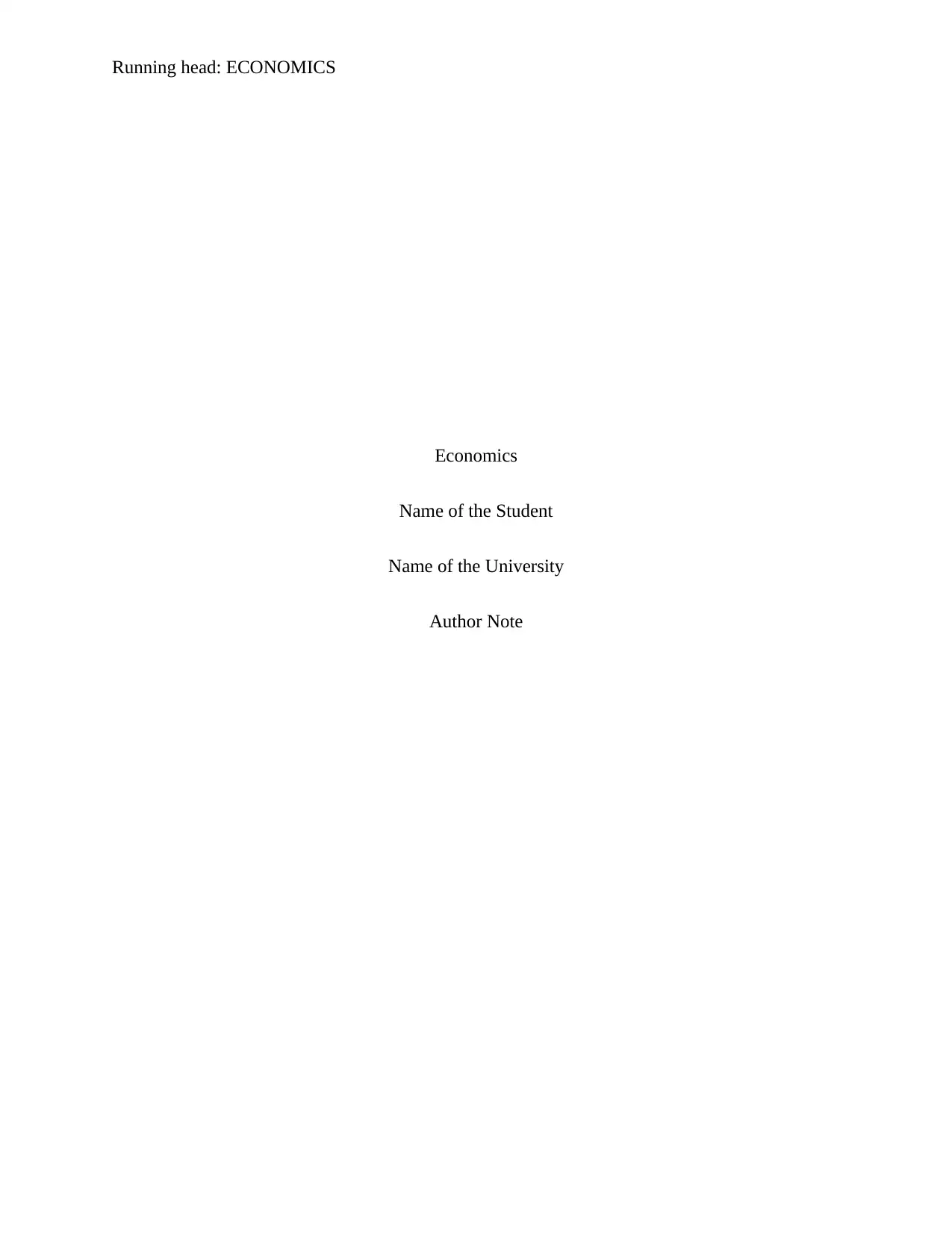
Running head: ECONOMICS
Economics
Name of the Student
Name of the University
Author Note
Economics
Name of the Student
Name of the University
Author Note
Paraphrase This Document
Need a fresh take? Get an instant paraphrase of this document with our AI Paraphraser
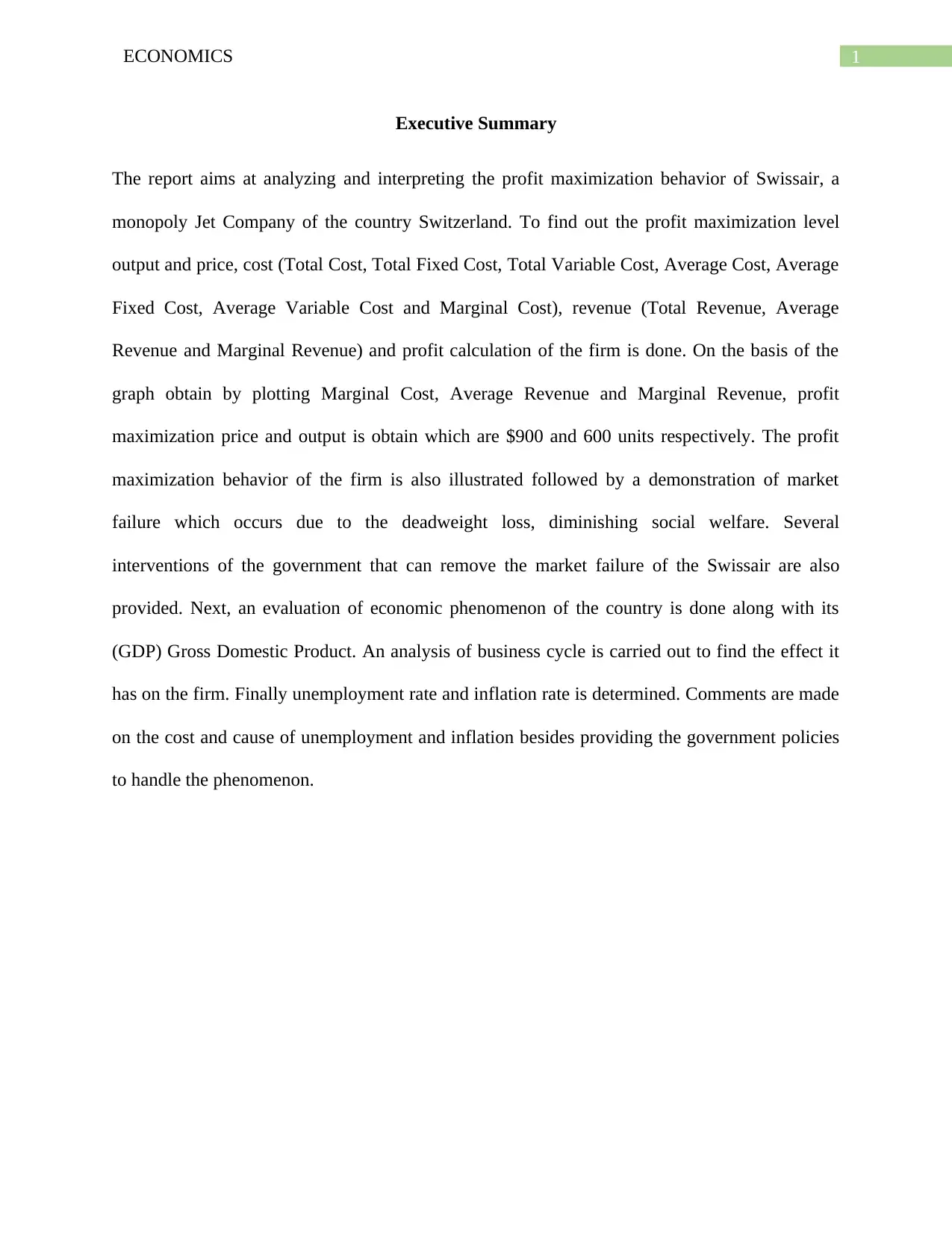
1ECONOMICS
Executive Summary
The report aims at analyzing and interpreting the profit maximization behavior of Swissair, a
monopoly Jet Company of the country Switzerland. To find out the profit maximization level
output and price, cost (Total Cost, Total Fixed Cost, Total Variable Cost, Average Cost, Average
Fixed Cost, Average Variable Cost and Marginal Cost), revenue (Total Revenue, Average
Revenue and Marginal Revenue) and profit calculation of the firm is done. On the basis of the
graph obtain by plotting Marginal Cost, Average Revenue and Marginal Revenue, profit
maximization price and output is obtain which are $900 and 600 units respectively. The profit
maximization behavior of the firm is also illustrated followed by a demonstration of market
failure which occurs due to the deadweight loss, diminishing social welfare. Several
interventions of the government that can remove the market failure of the Swissair are also
provided. Next, an evaluation of economic phenomenon of the country is done along with its
(GDP) Gross Domestic Product. An analysis of business cycle is carried out to find the effect it
has on the firm. Finally unemployment rate and inflation rate is determined. Comments are made
on the cost and cause of unemployment and inflation besides providing the government policies
to handle the phenomenon.
Executive Summary
The report aims at analyzing and interpreting the profit maximization behavior of Swissair, a
monopoly Jet Company of the country Switzerland. To find out the profit maximization level
output and price, cost (Total Cost, Total Fixed Cost, Total Variable Cost, Average Cost, Average
Fixed Cost, Average Variable Cost and Marginal Cost), revenue (Total Revenue, Average
Revenue and Marginal Revenue) and profit calculation of the firm is done. On the basis of the
graph obtain by plotting Marginal Cost, Average Revenue and Marginal Revenue, profit
maximization price and output is obtain which are $900 and 600 units respectively. The profit
maximization behavior of the firm is also illustrated followed by a demonstration of market
failure which occurs due to the deadweight loss, diminishing social welfare. Several
interventions of the government that can remove the market failure of the Swissair are also
provided. Next, an evaluation of economic phenomenon of the country is done along with its
(GDP) Gross Domestic Product. An analysis of business cycle is carried out to find the effect it
has on the firm. Finally unemployment rate and inflation rate is determined. Comments are made
on the cost and cause of unemployment and inflation besides providing the government policies
to handle the phenomenon.
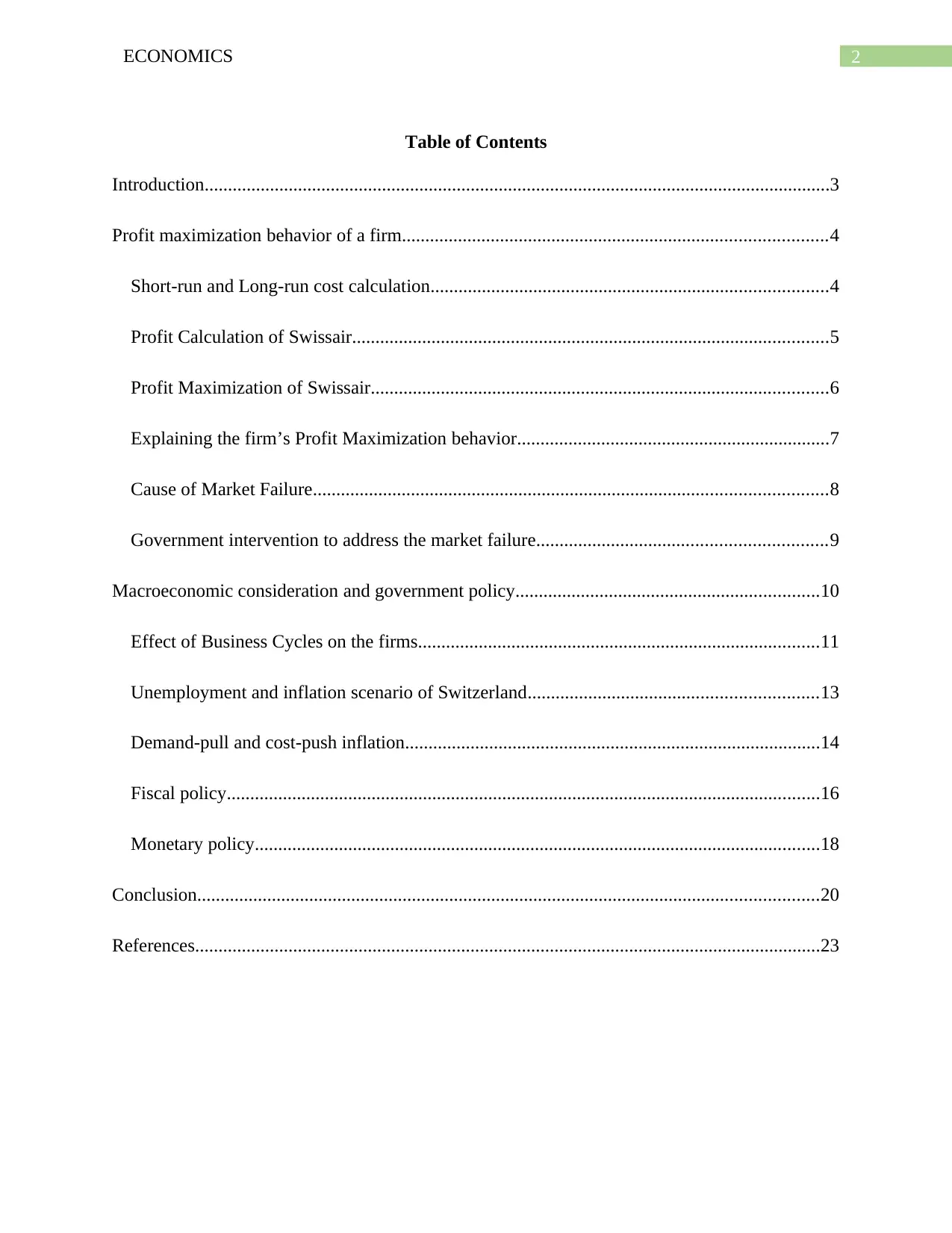
2ECONOMICS
Table of Contents
Introduction......................................................................................................................................3
Profit maximization behavior of a firm...........................................................................................4
Short-run and Long-run cost calculation.....................................................................................4
Profit Calculation of Swissair......................................................................................................5
Profit Maximization of Swissair..................................................................................................6
Explaining the firm’s Profit Maximization behavior...................................................................7
Cause of Market Failure..............................................................................................................8
Government intervention to address the market failure..............................................................9
Macroeconomic consideration and government policy.................................................................10
Effect of Business Cycles on the firms......................................................................................11
Unemployment and inflation scenario of Switzerland..............................................................13
Demand-pull and cost-push inflation.........................................................................................14
Fiscal policy...............................................................................................................................16
Monetary policy.........................................................................................................................18
Conclusion.....................................................................................................................................20
References......................................................................................................................................23
Table of Contents
Introduction......................................................................................................................................3
Profit maximization behavior of a firm...........................................................................................4
Short-run and Long-run cost calculation.....................................................................................4
Profit Calculation of Swissair......................................................................................................5
Profit Maximization of Swissair..................................................................................................6
Explaining the firm’s Profit Maximization behavior...................................................................7
Cause of Market Failure..............................................................................................................8
Government intervention to address the market failure..............................................................9
Macroeconomic consideration and government policy.................................................................10
Effect of Business Cycles on the firms......................................................................................11
Unemployment and inflation scenario of Switzerland..............................................................13
Demand-pull and cost-push inflation.........................................................................................14
Fiscal policy...............................................................................................................................16
Monetary policy.........................................................................................................................18
Conclusion.....................................................................................................................................20
References......................................................................................................................................23
⊘ This is a preview!⊘
Do you want full access?
Subscribe today to unlock all pages.

Trusted by 1+ million students worldwide
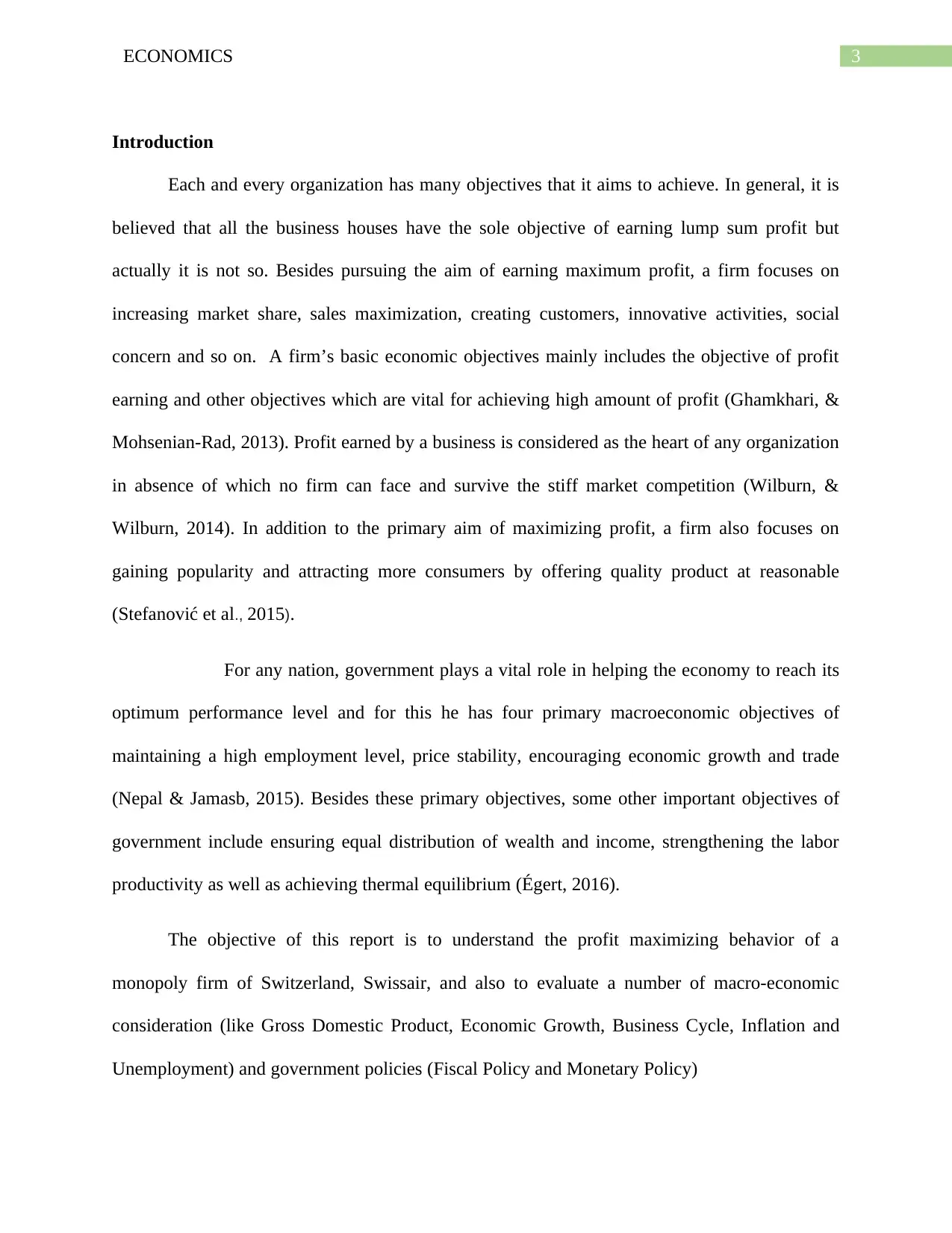
3ECONOMICS
Introduction
Each and every organization has many objectives that it aims to achieve. In general, it is
believed that all the business houses have the sole objective of earning lump sum profit but
actually it is not so. Besides pursuing the aim of earning maximum profit, a firm focuses on
increasing market share, sales maximization, creating customers, innovative activities, social
concern and so on. A firm’s basic economic objectives mainly includes the objective of profit
earning and other objectives which are vital for achieving high amount of profit (Ghamkhari, &
Mohsenian-Rad, 2013). Profit earned by a business is considered as the heart of any organization
in absence of which no firm can face and survive the stiff market competition (Wilburn, &
Wilburn, 2014). In addition to the primary aim of maximizing profit, a firm also focuses on
gaining popularity and attracting more consumers by offering quality product at reasonable
(Stefanović et al., 2015).
For any nation, government plays a vital role in helping the economy to reach its
optimum performance level and for this he has four primary macroeconomic objectives of
maintaining a high employment level, price stability, encouraging economic growth and trade
(Nepal & Jamasb, 2015). Besides these primary objectives, some other important objectives of
government include ensuring equal distribution of wealth and income, strengthening the labor
productivity as well as achieving thermal equilibrium (Égert, 2016).
The objective of this report is to understand the profit maximizing behavior of a
monopoly firm of Switzerland, Swissair, and also to evaluate a number of macro-economic
consideration (like Gross Domestic Product, Economic Growth, Business Cycle, Inflation and
Unemployment) and government policies (Fiscal Policy and Monetary Policy)
Introduction
Each and every organization has many objectives that it aims to achieve. In general, it is
believed that all the business houses have the sole objective of earning lump sum profit but
actually it is not so. Besides pursuing the aim of earning maximum profit, a firm focuses on
increasing market share, sales maximization, creating customers, innovative activities, social
concern and so on. A firm’s basic economic objectives mainly includes the objective of profit
earning and other objectives which are vital for achieving high amount of profit (Ghamkhari, &
Mohsenian-Rad, 2013). Profit earned by a business is considered as the heart of any organization
in absence of which no firm can face and survive the stiff market competition (Wilburn, &
Wilburn, 2014). In addition to the primary aim of maximizing profit, a firm also focuses on
gaining popularity and attracting more consumers by offering quality product at reasonable
(Stefanović et al., 2015).
For any nation, government plays a vital role in helping the economy to reach its
optimum performance level and for this he has four primary macroeconomic objectives of
maintaining a high employment level, price stability, encouraging economic growth and trade
(Nepal & Jamasb, 2015). Besides these primary objectives, some other important objectives of
government include ensuring equal distribution of wealth and income, strengthening the labor
productivity as well as achieving thermal equilibrium (Égert, 2016).
The objective of this report is to understand the profit maximizing behavior of a
monopoly firm of Switzerland, Swissair, and also to evaluate a number of macro-economic
consideration (like Gross Domestic Product, Economic Growth, Business Cycle, Inflation and
Unemployment) and government policies (Fiscal Policy and Monetary Policy)
Paraphrase This Document
Need a fresh take? Get an instant paraphrase of this document with our AI Paraphraser
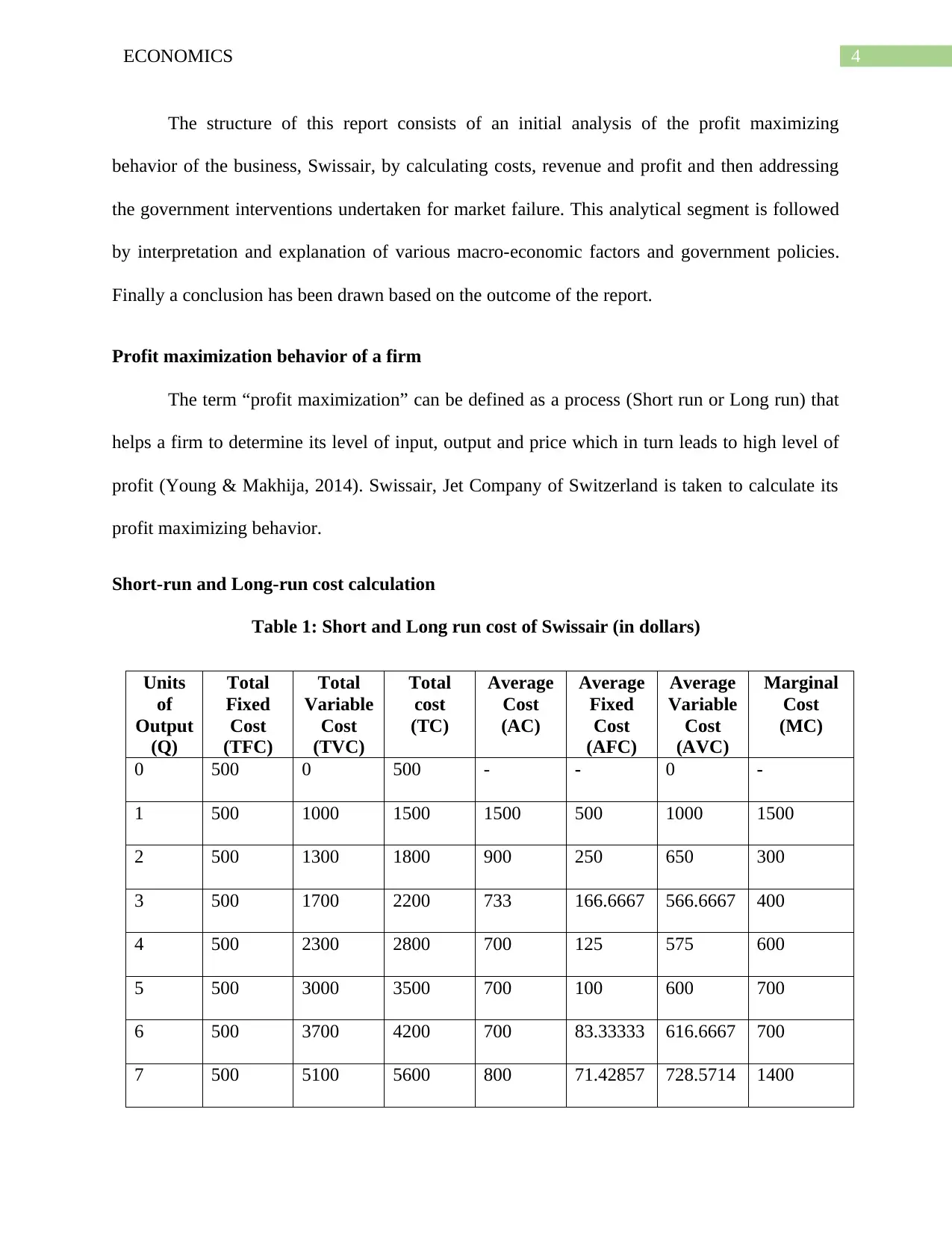
4ECONOMICS
The structure of this report consists of an initial analysis of the profit maximizing
behavior of the business, Swissair, by calculating costs, revenue and profit and then addressing
the government interventions undertaken for market failure. This analytical segment is followed
by interpretation and explanation of various macro-economic factors and government policies.
Finally a conclusion has been drawn based on the outcome of the report.
Profit maximization behavior of a firm
The term “profit maximization” can be defined as a process (Short run or Long run) that
helps a firm to determine its level of input, output and price which in turn leads to high level of
profit (Young & Makhija, 2014). Swissair, Jet Company of Switzerland is taken to calculate its
profit maximizing behavior.
Short-run and Long-run cost calculation
Table 1: Short and Long run cost of Swissair (in dollars)
Units
of
Output
(Q)
Total
Fixed
Cost
(TFC)
Total
Variable
Cost
(TVC)
Total
cost
(TC)
Average
Cost
(AC)
Average
Fixed
Cost
(AFC)
Average
Variable
Cost
(AVC)
Marginal
Cost
(MC)
0 500 0 500 - - 0 -
1 500 1000 1500 1500 500 1000 1500
2 500 1300 1800 900 250 650 300
3 500 1700 2200 733 166.6667 566.6667 400
4 500 2300 2800 700 125 575 600
5 500 3000 3500 700 100 600 700
6 500 3700 4200 700 83.33333 616.6667 700
7 500 5100 5600 800 71.42857 728.5714 1400
The structure of this report consists of an initial analysis of the profit maximizing
behavior of the business, Swissair, by calculating costs, revenue and profit and then addressing
the government interventions undertaken for market failure. This analytical segment is followed
by interpretation and explanation of various macro-economic factors and government policies.
Finally a conclusion has been drawn based on the outcome of the report.
Profit maximization behavior of a firm
The term “profit maximization” can be defined as a process (Short run or Long run) that
helps a firm to determine its level of input, output and price which in turn leads to high level of
profit (Young & Makhija, 2014). Swissair, Jet Company of Switzerland is taken to calculate its
profit maximizing behavior.
Short-run and Long-run cost calculation
Table 1: Short and Long run cost of Swissair (in dollars)
Units
of
Output
(Q)
Total
Fixed
Cost
(TFC)
Total
Variable
Cost
(TVC)
Total
cost
(TC)
Average
Cost
(AC)
Average
Fixed
Cost
(AFC)
Average
Variable
Cost
(AVC)
Marginal
Cost
(MC)
0 500 0 500 - - 0 -
1 500 1000 1500 1500 500 1000 1500
2 500 1300 1800 900 250 650 300
3 500 1700 2200 733 166.6667 566.6667 400
4 500 2300 2800 700 125 575 600
5 500 3000 3500 700 100 600 700
6 500 3700 4200 700 83.33333 616.6667 700
7 500 5100 5600 800 71.42857 728.5714 1400
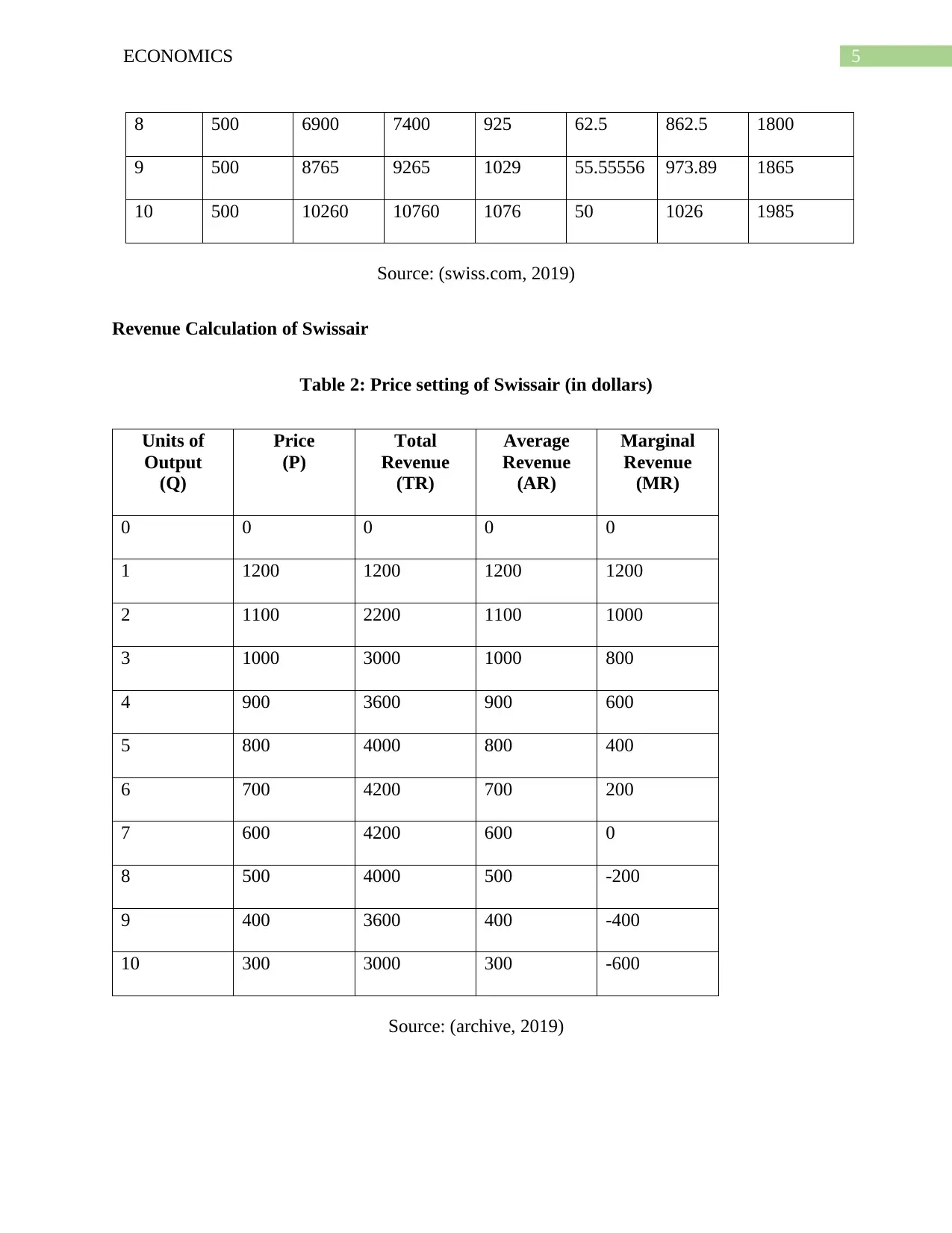
5ECONOMICS
8 500 6900 7400 925 62.5 862.5 1800
9 500 8765 9265 1029 55.55556 973.89 1865
10 500 10260 10760 1076 50 1026 1985
Source: (swiss.com, 2019)
Revenue Calculation of Swissair
Table 2: Price setting of Swissair (in dollars)
Units of
Output
(Q)
Price
(P)
Total
Revenue
(TR)
Average
Revenue
(AR)
Marginal
Revenue
(MR)
0 0 0 0 0
1 1200 1200 1200 1200
2 1100 2200 1100 1000
3 1000 3000 1000 800
4 900 3600 900 600
5 800 4000 800 400
6 700 4200 700 200
7 600 4200 600 0
8 500 4000 500 -200
9 400 3600 400 -400
10 300 3000 300 -600
Source: (archive, 2019)
8 500 6900 7400 925 62.5 862.5 1800
9 500 8765 9265 1029 55.55556 973.89 1865
10 500 10260 10760 1076 50 1026 1985
Source: (swiss.com, 2019)
Revenue Calculation of Swissair
Table 2: Price setting of Swissair (in dollars)
Units of
Output
(Q)
Price
(P)
Total
Revenue
(TR)
Average
Revenue
(AR)
Marginal
Revenue
(MR)
0 0 0 0 0
1 1200 1200 1200 1200
2 1100 2200 1100 1000
3 1000 3000 1000 800
4 900 3600 900 600
5 800 4000 800 400
6 700 4200 700 200
7 600 4200 600 0
8 500 4000 500 -200
9 400 3600 400 -400
10 300 3000 300 -600
Source: (archive, 2019)
⊘ This is a preview!⊘
Do you want full access?
Subscribe today to unlock all pages.

Trusted by 1+ million students worldwide
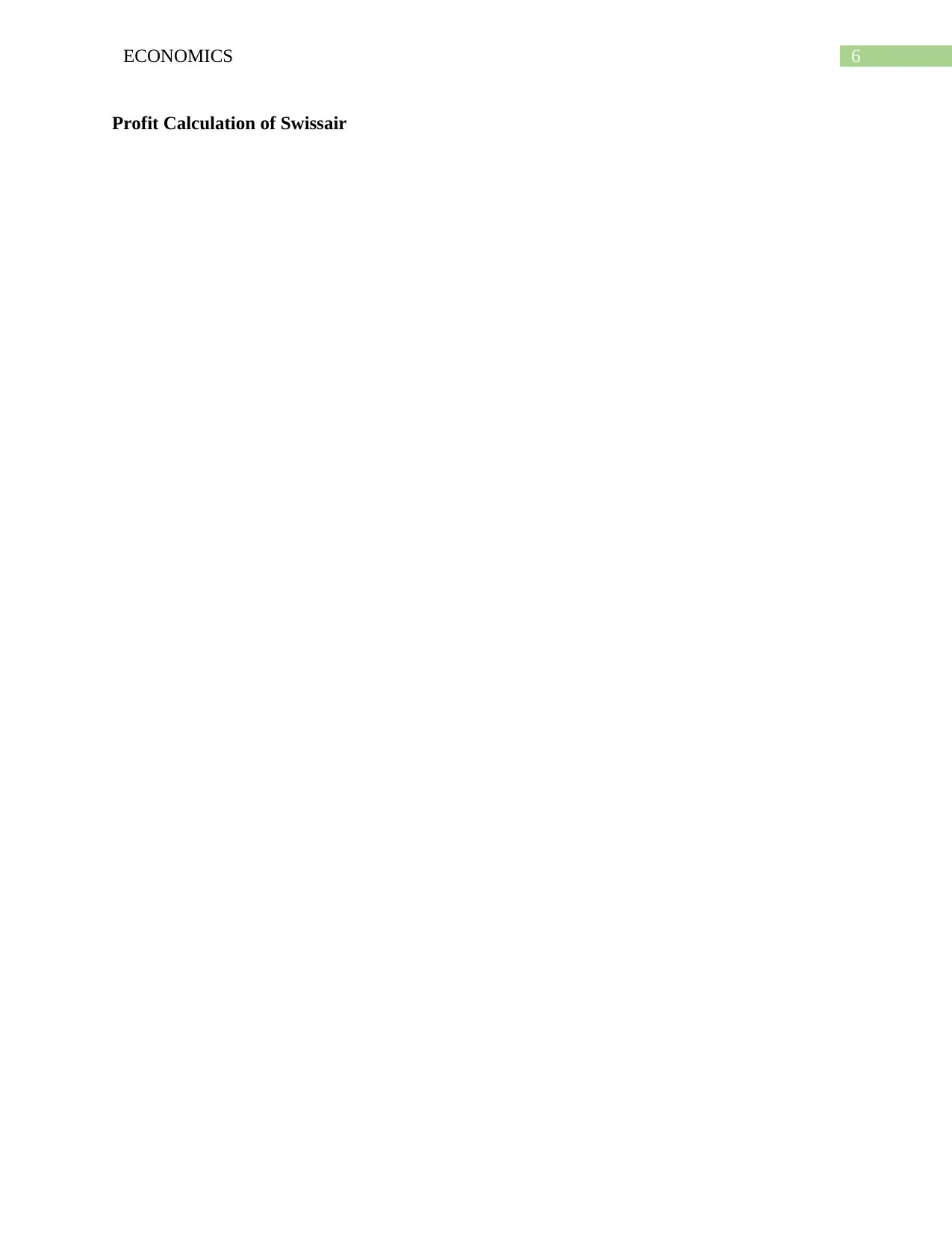
6ECONOMICS
Profit Calculation of Swissair
Profit Calculation of Swissair
Paraphrase This Document
Need a fresh take? Get an instant paraphrase of this document with our AI Paraphraser
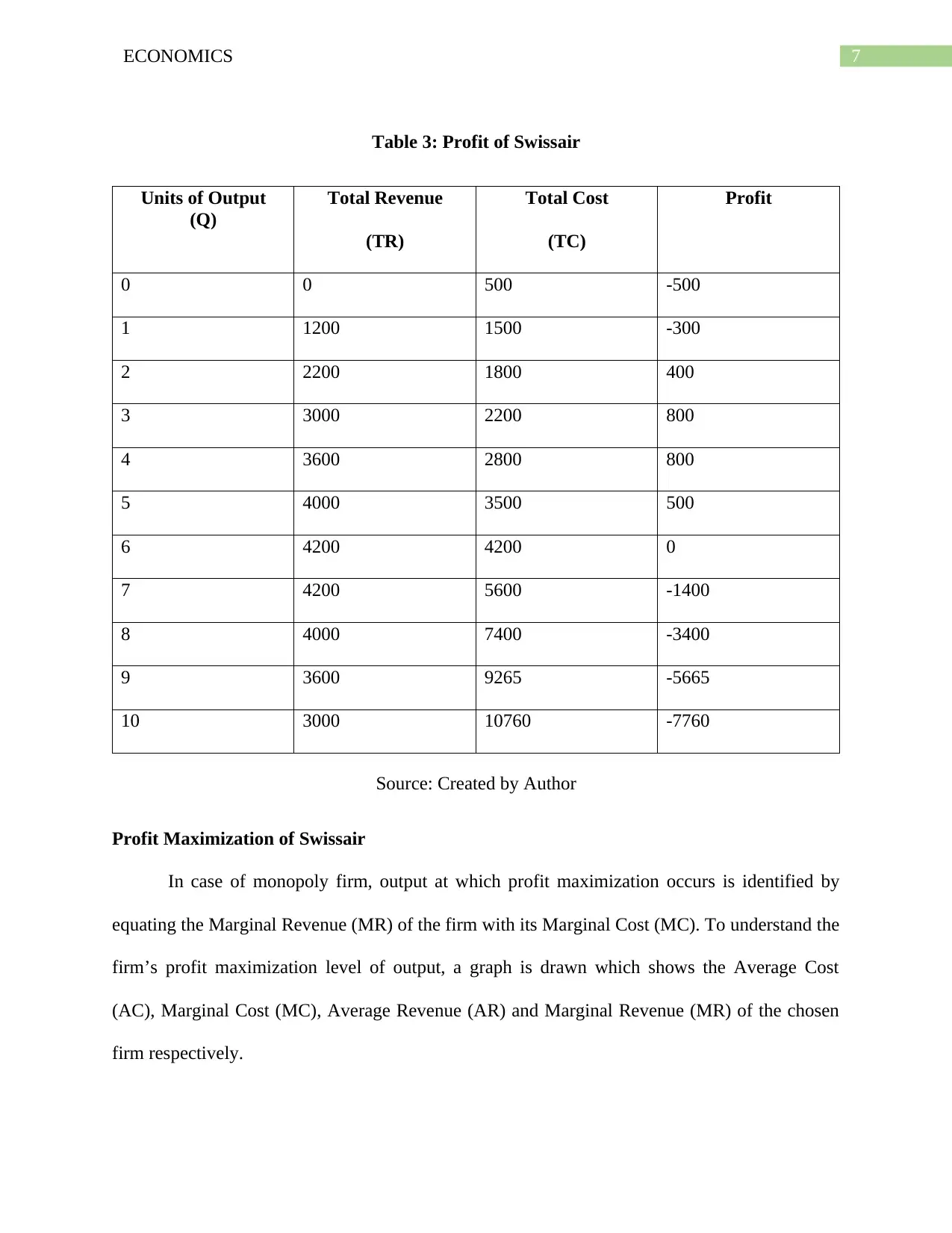
7ECONOMICS
Table 3: Profit of Swissair
Units of Output
(Q)
Total Revenue
(TR)
Total Cost
(TC)
Profit
0 0 500 -500
1 1200 1500 -300
2 2200 1800 400
3 3000 2200 800
4 3600 2800 800
5 4000 3500 500
6 4200 4200 0
7 4200 5600 -1400
8 4000 7400 -3400
9 3600 9265 -5665
10 3000 10760 -7760
Source: Created by Author
Profit Maximization of Swissair
In case of monopoly firm, output at which profit maximization occurs is identified by
equating the Marginal Revenue (MR) of the firm with its Marginal Cost (MC). To understand the
firm’s profit maximization level of output, a graph is drawn which shows the Average Cost
(AC), Marginal Cost (MC), Average Revenue (AR) and Marginal Revenue (MR) of the chosen
firm respectively.
Table 3: Profit of Swissair
Units of Output
(Q)
Total Revenue
(TR)
Total Cost
(TC)
Profit
0 0 500 -500
1 1200 1500 -300
2 2200 1800 400
3 3000 2200 800
4 3600 2800 800
5 4000 3500 500
6 4200 4200 0
7 4200 5600 -1400
8 4000 7400 -3400
9 3600 9265 -5665
10 3000 10760 -7760
Source: Created by Author
Profit Maximization of Swissair
In case of monopoly firm, output at which profit maximization occurs is identified by
equating the Marginal Revenue (MR) of the firm with its Marginal Cost (MC). To understand the
firm’s profit maximization level of output, a graph is drawn which shows the Average Cost
(AC), Marginal Cost (MC), Average Revenue (AR) and Marginal Revenue (MR) of the chosen
firm respectively.
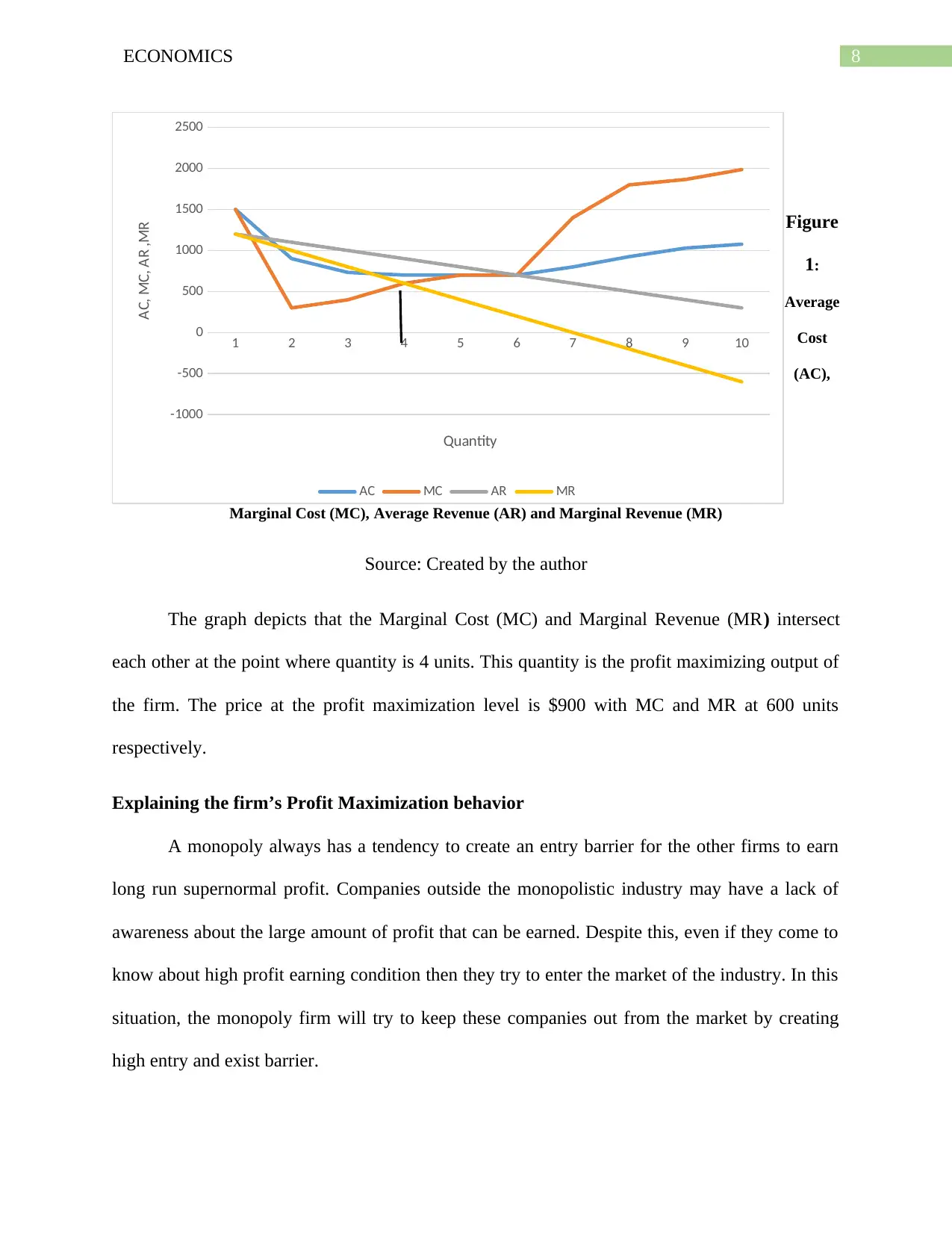
8ECONOMICS
Figure
1:
Average
Cost
(AC),
Marginal Cost (MC), Average Revenue (AR) and Marginal Revenue (MR)
Source: Created by the author
The graph depicts that the Marginal Cost (MC) and Marginal Revenue (MR) intersect
each other at the point where quantity is 4 units. This quantity is the profit maximizing output of
the firm. The price at the profit maximization level is $900 with MC and MR at 600 units
respectively.
Explaining the firm’s Profit Maximization behavior
A monopoly always has a tendency to create an entry barrier for the other firms to earn
long run supernormal profit. Companies outside the monopolistic industry may have a lack of
awareness about the large amount of profit that can be earned. Despite this, even if they come to
know about high profit earning condition then they try to enter the market of the industry. In this
situation, the monopoly firm will try to keep these companies out from the market by creating
high entry and exist barrier.
1 2 3 4 5 6 7 8 9 10
-1000
-500
0
500
1000
1500
2000
2500
AC MC AR MR
Quantity
AC, MC, AR ,MR
Figure
1:
Average
Cost
(AC),
Marginal Cost (MC), Average Revenue (AR) and Marginal Revenue (MR)
Source: Created by the author
The graph depicts that the Marginal Cost (MC) and Marginal Revenue (MR) intersect
each other at the point where quantity is 4 units. This quantity is the profit maximizing output of
the firm. The price at the profit maximization level is $900 with MC and MR at 600 units
respectively.
Explaining the firm’s Profit Maximization behavior
A monopoly always has a tendency to create an entry barrier for the other firms to earn
long run supernormal profit. Companies outside the monopolistic industry may have a lack of
awareness about the large amount of profit that can be earned. Despite this, even if they come to
know about high profit earning condition then they try to enter the market of the industry. In this
situation, the monopoly firm will try to keep these companies out from the market by creating
high entry and exist barrier.
1 2 3 4 5 6 7 8 9 10
-1000
-500
0
500
1000
1500
2000
2500
AC MC AR MR
Quantity
AC, MC, AR ,MR
⊘ This is a preview!⊘
Do you want full access?
Subscribe today to unlock all pages.

Trusted by 1+ million students worldwide
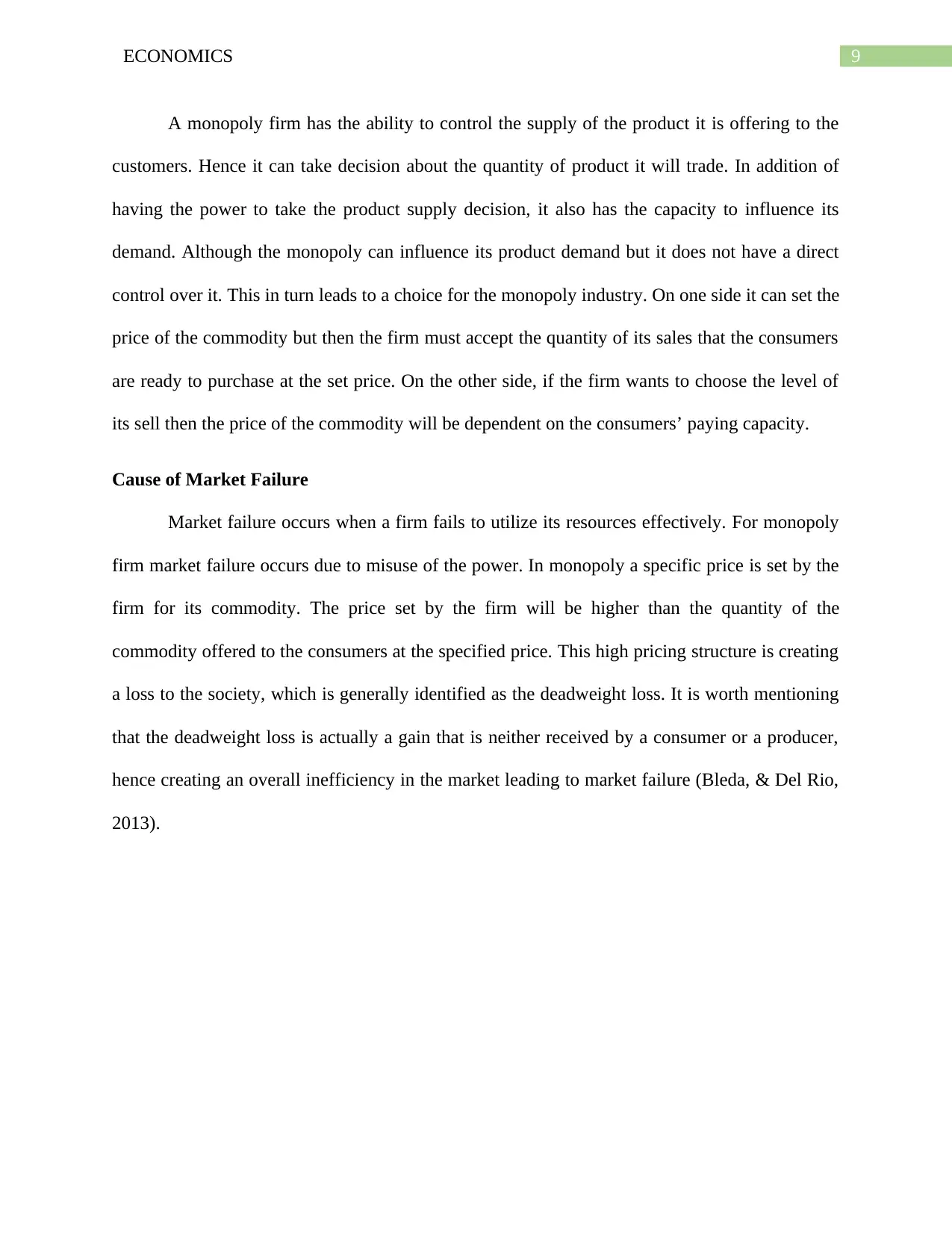
9ECONOMICS
A monopoly firm has the ability to control the supply of the product it is offering to the
customers. Hence it can take decision about the quantity of product it will trade. In addition of
having the power to take the product supply decision, it also has the capacity to influence its
demand. Although the monopoly can influence its product demand but it does not have a direct
control over it. This in turn leads to a choice for the monopoly industry. On one side it can set the
price of the commodity but then the firm must accept the quantity of its sales that the consumers
are ready to purchase at the set price. On the other side, if the firm wants to choose the level of
its sell then the price of the commodity will be dependent on the consumers’ paying capacity.
Cause of Market Failure
Market failure occurs when a firm fails to utilize its resources effectively. For monopoly
firm market failure occurs due to misuse of the power. In monopoly a specific price is set by the
firm for its commodity. The price set by the firm will be higher than the quantity of the
commodity offered to the consumers at the specified price. This high pricing structure is creating
a loss to the society, which is generally identified as the deadweight loss. It is worth mentioning
that the deadweight loss is actually a gain that is neither received by a consumer or a producer,
hence creating an overall inefficiency in the market leading to market failure (Bleda, & Del Rio,
2013).
A monopoly firm has the ability to control the supply of the product it is offering to the
customers. Hence it can take decision about the quantity of product it will trade. In addition of
having the power to take the product supply decision, it also has the capacity to influence its
demand. Although the monopoly can influence its product demand but it does not have a direct
control over it. This in turn leads to a choice for the monopoly industry. On one side it can set the
price of the commodity but then the firm must accept the quantity of its sales that the consumers
are ready to purchase at the set price. On the other side, if the firm wants to choose the level of
its sell then the price of the commodity will be dependent on the consumers’ paying capacity.
Cause of Market Failure
Market failure occurs when a firm fails to utilize its resources effectively. For monopoly
firm market failure occurs due to misuse of the power. In monopoly a specific price is set by the
firm for its commodity. The price set by the firm will be higher than the quantity of the
commodity offered to the consumers at the specified price. This high pricing structure is creating
a loss to the society, which is generally identified as the deadweight loss. It is worth mentioning
that the deadweight loss is actually a gain that is neither received by a consumer or a producer,
hence creating an overall inefficiency in the market leading to market failure (Bleda, & Del Rio,
2013).
Paraphrase This Document
Need a fresh take? Get an instant paraphrase of this document with our AI Paraphraser
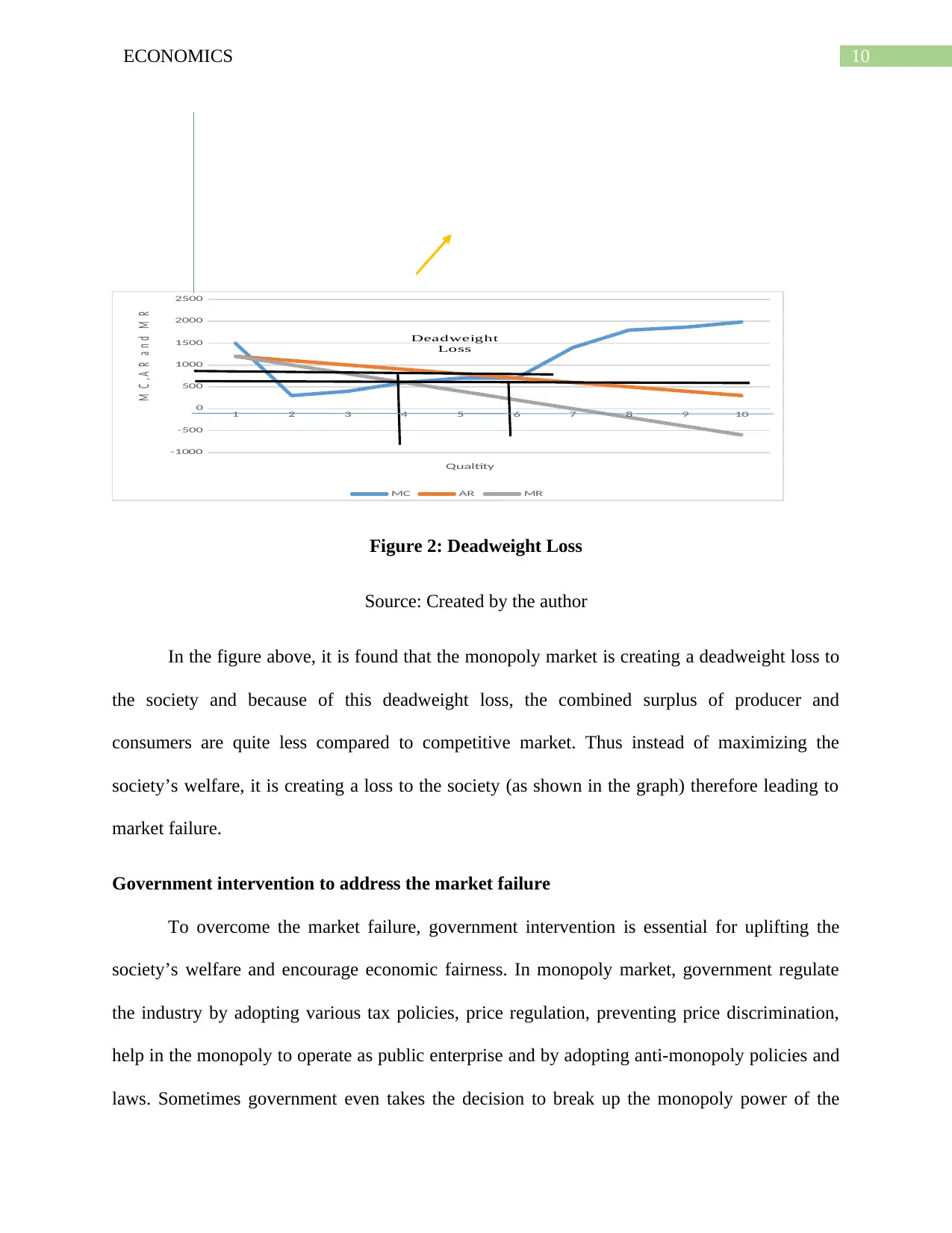
10ECONOMICS
1 2 3 4 5 6 7 8 9 10
-1000
-500
0
500
1000
1500
2000
2500
MC AR MR
Qualtity
M C , A R a n d M R
Deadweight
Loss
Figure 2: Deadweight Loss
Source: Created by the author
In the figure above, it is found that the monopoly market is creating a deadweight loss to
the society and because of this deadweight loss, the combined surplus of producer and
consumers are quite less compared to competitive market. Thus instead of maximizing the
society’s welfare, it is creating a loss to the society (as shown in the graph) therefore leading to
market failure.
Government intervention to address the market failure
To overcome the market failure, government intervention is essential for uplifting the
society’s welfare and encourage economic fairness. In monopoly market, government regulate
the industry by adopting various tax policies, price regulation, preventing price discrimination,
help in the monopoly to operate as public enterprise and by adopting anti-monopoly policies and
laws. Sometimes government even takes the decision to break up the monopoly power of the
1 2 3 4 5 6 7 8 9 10
-1000
-500
0
500
1000
1500
2000
2500
MC AR MR
Qualtity
M C , A R a n d M R
Deadweight
Loss
Figure 2: Deadweight Loss
Source: Created by the author
In the figure above, it is found that the monopoly market is creating a deadweight loss to
the society and because of this deadweight loss, the combined surplus of producer and
consumers are quite less compared to competitive market. Thus instead of maximizing the
society’s welfare, it is creating a loss to the society (as shown in the graph) therefore leading to
market failure.
Government intervention to address the market failure
To overcome the market failure, government intervention is essential for uplifting the
society’s welfare and encourage economic fairness. In monopoly market, government regulate
the industry by adopting various tax policies, price regulation, preventing price discrimination,
help in the monopoly to operate as public enterprise and by adopting anti-monopoly policies and
laws. Sometimes government even takes the decision to break up the monopoly power of the
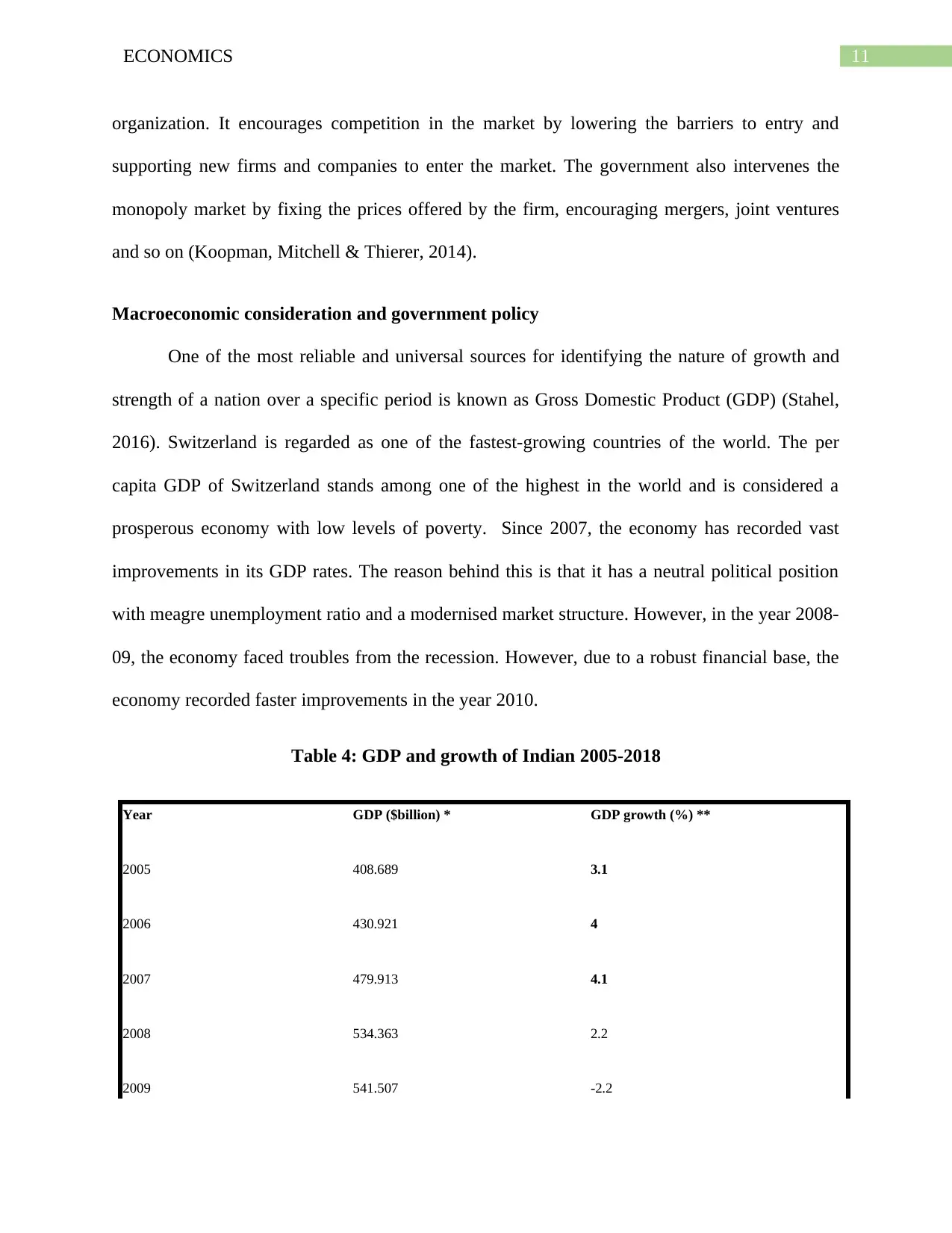
11ECONOMICS
organization. It encourages competition in the market by lowering the barriers to entry and
supporting new firms and companies to enter the market. The government also intervenes the
monopoly market by fixing the prices offered by the firm, encouraging mergers, joint ventures
and so on (Koopman, Mitchell & Thierer, 2014).
Macroeconomic consideration and government policy
One of the most reliable and universal sources for identifying the nature of growth and
strength of a nation over a specific period is known as Gross Domestic Product (GDP) (Stahel,
2016). Switzerland is regarded as one of the fastest-growing countries of the world. The per
capita GDP of Switzerland stands among one of the highest in the world and is considered a
prosperous economy with low levels of poverty. Since 2007, the economy has recorded vast
improvements in its GDP rates. The reason behind this is that it has a neutral political position
with meagre unemployment ratio and a modernised market structure. However, in the year 2008-
09, the economy faced troubles from the recession. However, due to a robust financial base, the
economy recorded faster improvements in the year 2010.
Table 4: GDP and growth of Indian 2005-2018
Year GDP ($billion) * GDP growth (%) **
2005 408.689 3.1
2006 430.921 4
2007 479.913 4.1
2008 534.363 2.2
2009 541.507 -2.2
organization. It encourages competition in the market by lowering the barriers to entry and
supporting new firms and companies to enter the market. The government also intervenes the
monopoly market by fixing the prices offered by the firm, encouraging mergers, joint ventures
and so on (Koopman, Mitchell & Thierer, 2014).
Macroeconomic consideration and government policy
One of the most reliable and universal sources for identifying the nature of growth and
strength of a nation over a specific period is known as Gross Domestic Product (GDP) (Stahel,
2016). Switzerland is regarded as one of the fastest-growing countries of the world. The per
capita GDP of Switzerland stands among one of the highest in the world and is considered a
prosperous economy with low levels of poverty. Since 2007, the economy has recorded vast
improvements in its GDP rates. The reason behind this is that it has a neutral political position
with meagre unemployment ratio and a modernised market structure. However, in the year 2008-
09, the economy faced troubles from the recession. However, due to a robust financial base, the
economy recorded faster improvements in the year 2010.
Table 4: GDP and growth of Indian 2005-2018
Year GDP ($billion) * GDP growth (%) **
2005 408.689 3.1
2006 430.921 4
2007 479.913 4.1
2008 534.363 2.2
2009 541.507 -2.2
⊘ This is a preview!⊘
Do you want full access?
Subscribe today to unlock all pages.

Trusted by 1+ million students worldwide
1 out of 27
Related Documents
Your All-in-One AI-Powered Toolkit for Academic Success.
+13062052269
info@desklib.com
Available 24*7 on WhatsApp / Email
![[object Object]](/_next/static/media/star-bottom.7253800d.svg)
Unlock your academic potential
Copyright © 2020–2025 A2Z Services. All Rights Reserved. Developed and managed by ZUCOL.





